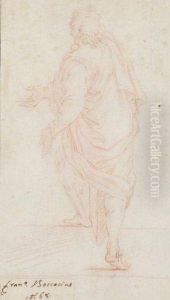Francesco Boccaccino Paintings
Francesco Boccaccino was an Italian painter of the Baroque period, born in 1672 in Cremona, a city in the Lombardy region of northern Italy, which was a significant center for violin making and art during the 17th century. He is often confused with his more famous father, Camillo Boccaccino, who was also a prominent painter in Cremona. Despite the overshadowing fame of his father, Francesco developed his own artistic style and contributed to the artistic scene of his time.
Francesco Boccaccino's work was influenced by the prevailing Baroque style, characterized by dramatic expression, rich coloration, and a strong sense of movement. There is not as much information available on Francesco's training as there is for his father, but it is assumed that he received his early training in the workshop of his father. Like many artists of the era, his work may have been influenced by the travels he undertook and the artists he met and worked with throughout his career.
While Boccaccino's oeuvre has not been studied as extensively as that of some of his contemporaries, he did produce a number of religious works, including altarpieces and frescoes for churches in Cremona and its surrounding areas. His paintings were appreciated for their devotional quality and their ability to communicate religious narratives effectively to worshippers.
Francesco Boccaccino's career seems to have been a modest one, without the high-profile commissions that marked the careers of the leading artists of the day. Nevertheless, he was a respected member of the local art community in Cremona. The historical record indicates that he continued to paint up until his death in 1750. His works today are less well-known and are often overshadowed by the output of his father and other more prominent figures of the Italian Baroque. However, they remain a testament to the regional variations of Baroque painting in Italy and provide insight into the devotional art of the period.
